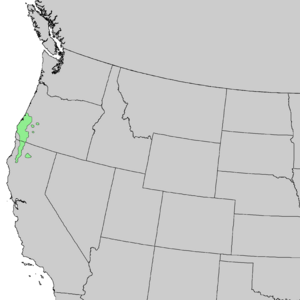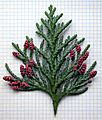Chamaecyparis lawsoniana facts for kids
Quick facts for kids Chamaecyparis lawsoniana |
|
|---|---|
 |
|
| Old-growth stand of C. lawsoniana in California | |
| Conservation status | |
| Scientific classification | |
| Genus: |
Chamaecyparis
|
| Species: |
lawsoniana
|
 |
|
| Natural range of Port Orford cedar | |
The Chamaecyparis lawsoniana, also known as Port Orford cedar or Lawson cypress, is a type of conifer tree. It belongs to the Chamaecyparis genus in the Cupressaceae family. This tree naturally grows in Oregon and northwestern California. You can find it from sea level up to about 1,500 meters (4,900 feet) high. It often grows in the valleys of the Klamath Mountains, especially near streams.
Contents
What Does the Port Orford Cedar Look Like?
This is a very large evergreen tree. It can grow taller than 60 meters (200 feet) and its trunk can be 1.2 to 2 meters (4 to 7 feet) wide. Its leaves are like scales, about 3 to 5 millimeters (0.12 to 0.20 inches) long. They are often a blue-green color and grow in flat, feathery sprays. If you look closely, you'll see narrow white marks on the underside of the leaves. The foliage has a strong smell, a bit like parsley.
The tree produces small, round seed cones. These cones are 7 to 14 millimeters (0.28 to 0.55 inches) wide and have 6 to 10 scales. They start green and turn brown in early fall, about 6 to 8 months after the tree is pollinated. The male cones are smaller, about 3 to 4 millimeters (0.12 to 0.16 inches) long. They are dark red and turn brown when they release pollen in early spring. The bark of the tree is reddish-brown and looks like fibrous strips.
How Did It Get Its Name?
Euro-Americans first found this tree near Port Orford, Oregon in 1854. It was brought into gardens by collectors working for Charles Lawson. He owned a plant nursery in Edinburgh, Scotland. The tree was named Lawson Cypress after him by the botanist Andrew Murray.
In the United States, the USDA officially calls it Port Orford cedar. Most people in its native area use this name too. However, some scientists prefer to call it Lawson cypress. The name "Lawson's cypress" is very common in gardening.
What is the Wood Used For?
The wood of the Port Orford cedar is light but very strong. It also resists rot well. This makes it highly valued, especially in East Asia. A lot of this wood is sent to Japan. There, it is used to make coffins, shrines, and temples. The wood is also known for its strong, pleasant ginger smell.
Because its grain is very straight, it's a popular choice for making arrow shafts. It can also be used for building aircraft, though it's not the top choice. However, it's considered excellent for musical instruments with strings, like guitars. Its fine grain, strength, and good sound quality are highly praised for making the soundboards of these instruments.
Growing Port Orford Cedar
Chamaecyparis lawsoniana grows best in soil that drains well but stays moist. It likes a fairly protected spot with full sun. There are hundreds of different types, called cultivars, that people have chosen for planting in parks and gardens. These types have different shapes, growth rates, and leaf colors.
In the UK, many of these cultivars have won the Royal Horticultural Society's Award of Garden Merit. Here are some examples:
| Name | Height (m) | Spread (m) | Shape | Foliage Colour | Ref. |
|---|---|---|---|---|---|
| 'Aurea Densa' | 1.5 | 1.0 | broadly conical | yellow-green | |
| 'Chilworth Silver' | 2.5 | 1.0 | broadly columnar | silver-blue | |
| 'Dik's Weeping' | 12.0 | 4.0 | columnar, weeping | blue-green | |
| 'Ellwoodii' | 8.0 | 4.0 | columnar | grey-green | |
| 'Ellwood's Gold' | 4.0 | 1.0 | columnar | yellow/grey-green | |
| 'Ellwood's Pillar' | 2.5 | 1.5 | narrowly columnar | grey-green | |
| 'Fletcheri' | 12.0 | 4.0 | columnar | grey-green | |
| 'Gimbornii' | 2.5 | 2.5 | rounded | grey-green | |
| 'Golden Wonder' | 20.0 | 4.0 | columnar | yellow-green | |
| 'Grayswood Feather' | 4.0 | 1.5 | narrowly columnar | green | |
| 'Green Globe' | 0.3 | 0.3 | rounded | dark green | |
| 'Imbricata Pendula' | 8.0 | 4.0 | conical, weeping, pendulous | green | |
| 'Kilmacurragh' | 12.0 | 4.0 | columnar | dark green | |
| 'Lanei Aurea' | 8.0 | 2.5 | columnar | yellow-green | |
| 'Little Spire' | 2.5 | 1.5 | conical | dark green | |
| 'Minima Aurea' | 1.0 | 1.0 | conical | yellow-green | |
| 'Minima Glauca' | 2.5 | 2.5 | rounded | blue-green | |
| 'Pembury Blue' | 12.00+ | 8.00 | conical | blue-green | |
| 'Pygmaea Argentea' | 2.5 | 1.0 | rounded | cream/blue-green | |
| 'Stardust' | 4.0 | 1.5 | columnar | yellow-green | |
| 'Summer Snow' | 2.5 | 1.5 | conical | cream/green | |
| 'Triomf van Boskoop' | 25.0 | 8.0 | broadly columnar | grey-green | |
| 'Wisselii' | 12.0+ | 4.0 | narrowly conical | blue-green | |
| 'Wissel's Saguaro' | 6.0 | 1.0 | narrow, upright | blue-green |
Threats to the Tree
In the wild, the Port Orford cedar is seriously threatened by a root disease. This disease is caused by a tiny organism called Phytophthora lateralis. This disease also affects trees planted in gardens in some parts of North America. Other types of Phytophthora can also harm the tree, but less often.
The Phytophthora lateralis infection starts when tiny parts of the organism, called mycelium, get into the tree's roots. The infection then spreads through the inner bark and the cambium (a layer under the bark) around the base of the tree. It usually doesn't spread far up the trunk. The infected parts of the tree die, which can cut off the tree's water and nutrients. Larger trees are more likely to get infected because they have bigger root systems. However, big trees can sometimes live with the infection for several years.
Trees growing near streams are very likely to get infected by Phytophthora lateralis. But in dry, uphill areas, the disease spreads slowly. Phytophthora lateralis spreads through water using tiny moving spores called zoospores. It also makes resting spores called chlamydospores that can stay in the soil for a long time.
New infections usually start when soil from an infected area is moved to a healthy area. This can happen through people or animals. Soil on vehicle tires, especially logging trucks, is a big problem. This is because a lot of soil can be carried, and these vehicles travel a lot between different areas. The disease can also spread on boots and mountain bike tires, causing new infections nearby. Animals can also spread it, but usually only over short distances.
Organizations like the Bureau of Land Management (BLM) and the United States Forest Service (USFS) try to stop the spread of Phytophthora. They do this by closing roads, watching for the disease, doing research, and teaching people about it. Their research tries to understand how the disease spreads and how to grow trees that can resist it. Some chemicals like Mancozeb (also known as Dithane (C)) can help fight Phytophthora. Also, a helpful fungus called Pythium oligandrum is known to attack many Phytophthora species.
Gallery
See also







